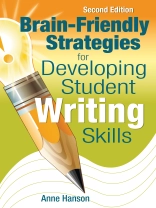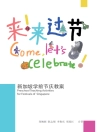‘Explains brain research in easy-to-understand language and includes real classroom stories from diverse grade levels and student populations. Any teacher who wants to support effective, brain-friendly instruction should read this book and share it with colleagues and administrators.’
—Bobbie Faulkner, Teacher
Scottsdale Unified School District, Phoenix, AZ
‘The major strengths are the implications of current brain research and how to maximize student learning and enjoyment in the learning process.’
—Mary Moore, Third-Grade Teacher
Jason Lee Elementary School, Richland, WA
A brain-based approach for nurturing the writer in every student!
Today′s world of high-stakes testing challenges teachers to find a balance between brain-centered and test-driven practices. This insightful book provides a framework for using brain-compatible strategies to develop confident and competent writers while meeting district and national standards.
The author applies core principles of effective teaching to writing instruction and shows teachers how to foster a love of writing in their classroom. Written in a user-friendly format, this revised edition of Write Brain Write features classroom stories, reflection questions, student examples, and activities for elementary, middle, and high school students to help teachers implement brain-friendly writing instruction. This resource provides information on:
- Creating a brain-compatible classroom based on how the brain learns
- Using a seven-step framework to promote writing skills
- Integrating test preparation with instruction to boost student achievement
- Cross-curricular writing in social studies, science, math, and language arts
Foster high literacy and increase performance on high-stakes tests while nurturing an authentic love for learning in every student!
Mục lục
Acknowledgments
About the Author
Preface
1. Introducing the Brain-Compatible Framework for Student Achievement
Four Brain-Compatible Classroom Principles
Five Core Propositions of Accomplished Teaching
Six Features of Effective Instruction
The Brain-Compatible Framework for Student Achievement
A Brain Journey
Celebrating the Learning Brain
21st-Century Brain-Compatible Teachers
21st-Century High-Stakes-Tested Students
Can You Hear Me Now?
Questions for Reflection
2. Making Connections Across Instruction, Curriculum, and Life
Characteristics of Feature One
Reflecting on the Brain-Compatible Framework and Feature One
The Brain-Compatible Framework With Feature One in Action
Learning About Our Students
Brain Surveys
Writing Connections
Writing: Pleasure or Pain?
Seven Stages of Brain-Friendly Writing Instruction
Verbs Are Your Friends: Describing Verbs
How, Why, and What Verbs
Questions for Reflection
3. Teaching Skills in Multiple Lesson Types
Characteristics of Feature Two
Separate, Simulated, and Integrated Instruction
Reflecting on the Brain-Compatible Framework and Feature Two
The Brain-Compatible Framework With Feature Two in Action
Questions for Reflection
4. Integrating Test Preparation Into Instruction
Characteristics of Feature Three?s Successful Teachers
Reflecting on the Brain-Compatible Framework and Feature Three
The Brain-Compatible Framework With Feature Three in Action
Test Savvy
Hero Quest
Questions for Reflection
5. Teaching Students Strategies for Doing the Work
Characteristics of Feature Four
Reflecting on the Brain-Compatible Framework and Feature Four
The Brain-Compatible Framework With Feature Four in Action
The Clue to Exact Writing
Setting the Stage for Authentic Assessment and Learning
Questions for Reflection
6. Expecting Generative Thinking
Characteristics of Feature Five
Reflecting on the Brain-Compatible Framework and Feature Five
The Brain-Compatible Framework and Feature Five in Action
Generative Thinking in Elementary School
Generative Thinking in Middle School
Generative Thinking in High School
Writing and Generative Thinking
Questions for Reflection
7. Fostering Cognitive Collaboration
Characteristics of Feature Six
Reflecting on the Brain-Compatible Framework and Feature Six
The Brain-Compatible Framework and Feature Six in Action
Collaboration and Seating Arrangements
Cognitive Collaboration Beyond the Classroom: Community Writing Partners
Celebrate the Results
Authors′ Day
Questions for Reflection
8. Envisioning Every Child as a Lifelong Learner
References
Index
Giới thiệu về tác giả
Anne Hanson is a doctor of educational leadership whose research study dealt with the psychological syndrome of burnout in the No Child Left Behind high-stakes testing workplace. A National Board Certified language arts teacher with over 20 years classroom experience, Hanson has worked as a peer evaluator, staff developer, and literacy coach for teachers and students.Serving as the foundation for all her workshops is the research-based understanding of the emotional well-being necessary to succeed in the workplace, whether school or business. Hanson’s career-long advocacy for teachers and students has influenced the design of her workshops, which are as diverse as her audiences, who range from administrators and teachers to parents and students from K-12 to the college level. Besides the first edition of Write Brain Write, Anne is the author of Visual Writing; “Writing” in The Praeger Handbook of Learning and the Brain; Wanted: Teachers for National Board Certification; and Thin Veils, a novel about deadly dieting. Hanson’s awards and recognitions include Arizona Teacher of the Year finalist; Scottsdale Middle School Teacher of the Year; Japan Fulbright Memorial Fund scholar; New York Council for the Humanities scholar; and Arizona State University Martin Luther King, Jr. Spirit Award.












